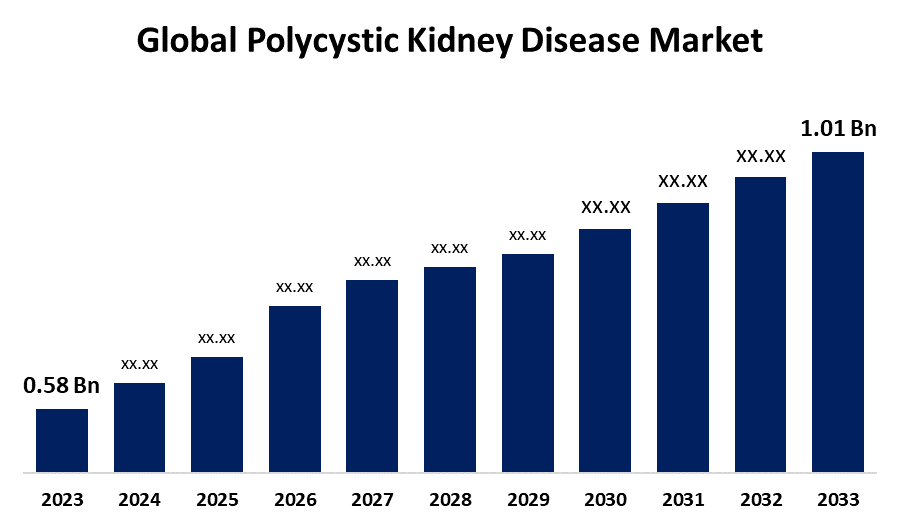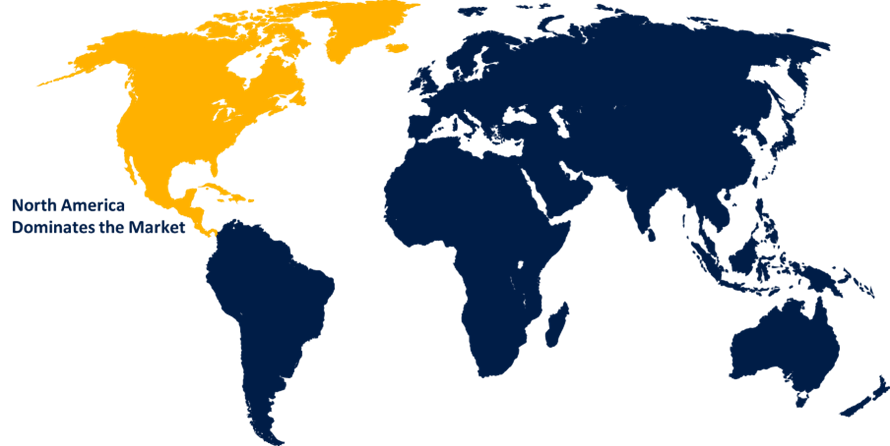Global Polycystic Kidney Disease Market Size, Share, and COVID-19 Impact Analysis, By Type (Autosomal Dominant Polycystic Kidney Disease (ADPKD) and Autosomal Recessive Polycystic Kidney Disease (ARPKD)), By Diagnosis (Genetic Testing, Ultrasound, MRI, and CT scans), By Treatment (Drug Therapy, Dialysis, and Kidney Transplantation), and By Region (North America, Europe, Asia-Pacific, Latin America, Middle East, and Africa), Analysis and Forecast 2023 - 2033
Industry: HealthcareGlobal Polycystic Kidney Disease Market Insights Forecasts to 2033
- The Global Polycystic Kidney Disease Market Size was Valued at USD 0.58 Billion in 2023
- The Market Size is Growing at a CAGR of 5.70% from 2023 to 2033
- The Worldwide Polycystic Kidney Disease Market Size is Expected to Reach USD 1.01 Billion by 2033
- Asia Pacific is Expected to Grow the fastest during the forecast period.

Get more details on this report -
The Global Polycystic Kidney Disease Market Size is Anticipated to Exceed USD 1.01 Billion by 2033, Growing at a CAGR of 5.70% from 2023 to 2033.
Market Overview
Polycystic kidney disease is a condition affecting the kidneys and other organs, causing the development of cysts that interfere with the kidney’s ability to filter waste products from the blood. This can lead to kidney failure and may also develop in other organs, particularly the liver. Common complications include hypertension, pain, hematuria, urinary tract infections, kidney stones, and heart valve abnormalities. People with polycystic kidney disease also have an increased risk of an aneurysm in the aorta or blood vessels at the base of the brain, which can be life-threatening if they tear or rupture. The global polycystic kidney disease market includes treatments aimed at managing symptoms, slowing disease progression, and improving patients' quality of life. Market growth is driven by increasing prevalence, advancements in diagnostics, and the development of novel therapies like tolvaptan, the first FDA-approved drug for PKD. Additionally, the rising demand for kidney transplants and dialysis in severe cases contributes to market expansion.
Report Coverage
This research report categorizes the market for the global polycystic kidney disease market based on various segments and regions forecasts revenue growth and analyzes trends in each submarket. The report analyses the key growth drivers, opportunities, and challenges influencing the global polycystic kidney disease market. Recent market developments and competitive strategies such as expansion, Product launch, and development, partnership, merger, and acquisition have been included to draw the competitive landscape in the market. The report strategically identifies and profiles the key market players and analyses their core competencies in each sub-segment of the global polycystic kidney disease market.
Global Polycystic Kidney Disease Market Report Coverage
| Report Coverage | Details |
|---|---|
| Base Year: | 2023 |
| Market Size in 2023: | USD 0.58 Billion |
| Forecast Period: | 2023-2033 |
| Forecast Period CAGR 2023-2033 : | 5.70% |
| 2033 Value Projection: | USD 1.01 Billion |
| Historical Data for: | 2019-2022 |
| No. of Pages: | 231 |
| Tables, Charts & Figures: | 110 |
| Segments covered: | By Type, By Diagnosis, By Treatment, By Region |
| Companies covered:: | Otsuka Pharmaceutical Co., Ltd., Sanofi, Johnson & Johnson, Novartis AG, AbbVie Inc., AstraZeneca, Merck & Co., Inc., Pfizer Inc., Bayer AG, Reata Pharmaceuticals, Inc., Eli Lilly and Company, Galapagos NV, Vertex Pharmaceuticals, Bristol-Myers Squibb, GlaxoSmithKline plc (GSK), and Others. |
| Pitfalls & Challenges: | Covid-19 Empact, Challenges, Growth, Analysis. |
Get more details on this report -
Driving Factors
Polycystic kidney disease (PKD) is driven by genetic disorders, early diagnosis awareness, and medical advancements. Genetic testing and imaging techniques enable early detection, while drug innovations slow disease progression. The growing demand for kidney transplants and dialysis services due to PKD patients' end-stage renal disease (ESRD) drives market growth. Research and government initiatives promote awareness and funding for rare diseases.
Restraining Factors
Polycystic kidney disease (PKD) faces challenges due to high treatment costs, limited therapies, and a lack of a definitive cure. Drugs like tolvaptan are expensive and may not be accessible to all patients, especially in low-income areas. Supportive care like dialysis or kidney transplants is resource-intensive and has long waiting periods. Low awareness and early diagnosis also hinder market growth and access to advanced treatment options.
Market Segmentation
The global polycystic kidney disease market share is classified into type, diagnosis, and treatment.
- The autosomal dominant polycystic kidney disease (ADPKD) segment is expected to hold the largest share of the global polycystic kidney disease market during the forecast period.
Based on the type, the global polycystic kidney disease market is divided into autosomal dominant polycystic kidney disease (ADPKD) and autosomal recessive polycystic kidney disease (ARPKD). Among these, the autosomal dominant polycystic kidney disease (ADPKD) segment is expected to hold the largest share of the global polycystic kidney disease market during the forecast period. This is due to its higher prevalence and longer disease progression. Advancements in drug therapies, increased awareness, and research focusing on targeted therapies contribute to this growth. The demand for ongoing treatments and management is also expected to increase.
- The genetic testing segment is expected to grow at the fastest CAGR in the global polycystic kidney disease market during the forecast period.
Based on the diagnosis, the global polycystic kidney disease market is divided into genetic testing, ultrasound, MRI, and CT scans. Among these, the genetic testing segment is expected to grow at the fastest CAGR in the global polycystic kidney disease market during the forecast period. This is due to advancements in technology, increased awareness of early diagnosis, and the adoption of personalized medicine. Research efforts to understand genetic mutations responsible for PKD are driving improved diagnostic tools. As costs decrease and healthcare providers prioritize early screening for at-risk individuals, this segment is likely to continue expanding.
- The drug therapy segment is expected to grow at the fastest CAGR in the global polycystic kidney disease market during the forecast period.
Based on the treatment, the global polycystic kidney disease market is divided into drug therapy, dialysis, and kidney transplantation. Among these, the drug therapy segment is expected to grow at the fastest CAGR in the global polycystic kidney disease market during the forecast period. This is due to the availability and approval of effective drugs like tolvaptan, less invasive treatment options, and ongoing research and development efforts. Early-stage disease management and non-invasive treatment options are key growth areas.
Regional Segment Analysis of the Global Polycystic kidney disease Market
- North America (U.S., Canada, Mexico)
- Europe (Germany, France, U.K., Italy, Spain, Rest of Europe)
- Asia-Pacific (China, Japan, India, Rest of APAC)
- South America (Brazil and the Rest of South America)
- The Middle East and Africa (UAE, South Africa, Rest of MEA)
North America is anticipated to hold the largest share of the global polycystic kidney disease market over the predicted timeframe.

Get more details on this report -
North America is anticipated to hold the largest share of the global polycystic kidney disease market over the predicted timeframe. The region is going to dominate the global polycystic kidney disease (PKD) market due to its advanced healthcare infrastructure, high awareness, research focus, leading pharmaceutical companies, ongoing clinical trials, innovative treatments like tolvaptan, and specialized healthcare services, backed by substantial spending.
Asia Pacific is expected to grow at the fastest pace in the global polycystic kidney disease market during the forecast period. The region is expected to experience the fastest growth in the global polycystic kidney disease (PKD) market due to rising chronic kidney disease prevalence, healthcare investments, and improved access to advanced diagnostics and treatments. This growth is driven by a large population base, early diagnosis demand, and innovative therapies.
Competitive Analysis:
The report offers the appropriate analysis of the key organizations/companies involved within the global polycystic kidney disease market along with a comparative evaluation primarily based on their product offering, business overviews, geographic presence, enterprise strategies, segment market share, and SWOT analysis. The report also provides an elaborative analysis focusing on the current news and developments of the companies, which includes product development, innovations, joint ventures, partnerships, mergers & acquisitions, strategic alliances, and others. This allows for the evaluation of the overall competition within the market.
List of Key Companies
- Otsuka Pharmaceutical Co., Ltd.
- Sanofi
- Johnson & Johnson
- Novartis AG
- AbbVie Inc.
- AstraZeneca
- Merck & Co., Inc.
- Pfizer Inc.
- Bayer AG
- Reata Pharmaceuticals, Inc.
- Eli Lilly and Company
- Galapagos NV
- Vertex Pharmaceuticals
- Bristol-Myers Squibb
- GlaxoSmithKline plc (GSK)
- Others
Key Target Audience
- Market Players
- Investors
- End-users
- Government Authorities
- Consulting And Research Firm
- Venture capitalists
- Value-Added Resellers (VARs)
Recent Developments
- In June 2024, Regulus Therapeutics reported positive results from the third patient cohort in its Phase 1b MAD study of RGLS8429 for ADPKD treatment.
- In March 2024, Vertex Pharmaceuticals received FDA clearance for its first-in-class small molecule corrector, VX-407, which targets the underlying cause of autosomal dominant polycystic kidney disease in patients with PKD1 genetic variants.
Market Segment
This study forecasts revenue at global, regional, and country levels from 2020 to 2033. Spherical Insights has segmented the global polycystic kidney disease market based on the below-mentioned segments:
Global Polycystic Kidney Disease Market, By Type
- Autosomal Dominant Polycystic Kidney Disease (ADPKD)
- Autosomal Recessive Polycystic Kidney Disease (ARPKD)
Global Polycystic Kidney Disease Market, By Diagnosis
- Genetic Testing
- Ultrasound
- MRI
- CT Scans
Global Polycystic Kidney Disease Market, By Treatment
- Drug Therapy
- Dialysis
- Kidney Transplantation
Global Polycystic Kidney Disease Market, Regional
- North America
- US
- Canada
- Mexico
- Europe
- Germany
- UK
- France
- Italy
- Spain
- Russia
- Rest of Europe
- Asia Pacific
- China
- Japan
- India
- South Korea
- Australia
- Rest of Asia Pacific
- South America
- Brazil
- Argentina
- Rest of South America
- Middle East & Africa
- UAE
- Saudi Arabia
- Qatar
- South Africa
- Rest of the Middle East & Africa
Frequently Asked Questions (FAQ)
-
1. Which are the key companies that are currently operating within the market?Otsuka Pharmaceutical Co., Ltd., Sanofi, Johnson & Johnson, Novartis AG, AbbVie Inc., AstraZeneca, Merck & Co., Inc., Pfizer Inc., Bayer AG, Reata Pharmaceuticals, Inc., Eli Lilly and Company, Galapagos NV, Vertex Pharmaceuticals, Bristol-Myers Squibb, GlaxoSmithKline plc (GSK), and Others.
-
2. What is the size of the global polycystic kidney disease market?The Global Polycystic Kidney Disease Market is expected to grow from USD 0.58 Billion in 2023 to USD 1.01 Billion by 2033, at a CAGR of 5.70% during the forecast period 2023-2033.
-
3. Which region is holding the largest share of the market?North America is anticipated to hold the largest share of the global polycystic kidney disease market over the predicted timeframe.
Need help to buy this report?